By Ryan Penny
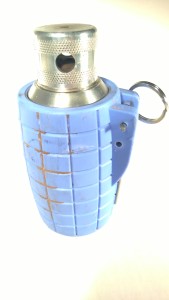
Are you looking for an effective yet economical training grenade solution? The Versatile Training Grenade or V.T.G. manufactured by S.W.A.T Training Devices Limited out of the United Kingdom might be what you are looking for. I have had the V.T.G. grenade version 1 for about three years now and so far it is holding up very well minus a few minor scrapes and dings from use. It weighs in at about 10.38oz which is pretty close to an M67 in weight at 14oz, so it has a decent enough mass for a simulation grenade.
Construction is made out of aluminum which is encased in a polymer casing that is sold in different colors to meet your needs. I opted for the blue color since it is usually the color used to denote training devices and it also helps make the device easier to spot if thrown into an area with overgrown vegetation as compared to the darker colors. The spoon and retention pin are made of a durable steel which appears to be holding up very well under normal use, with no bends or other deformations.
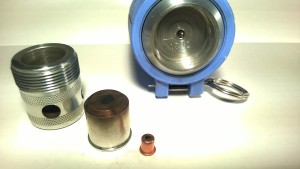
The beauty of the VTG grenade is its reliability. The thing is just a work horse. I have struggled and witnessed countless others struggle with other grenade options where they fail to detonate consistently. With the V.T.G. I never worry about a failed detonation. It goes off every time all the time.
To reload the grenade all you do is unscrew the cap. Remove the spent blank casing, the casing may or may not free fall out and in the case it doesn’t fall free on its own you can use your reloading tool that comes with the grenade to push the casing out. After the spent casing is removed, simply add a new blank casing to the cap.
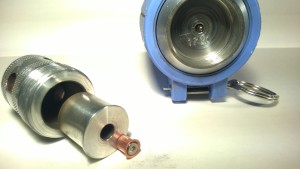
Next you will need to reset the firing pin mechanism in the grenade. To do this you hold the grenade in one hand and with the loading tool in the other you place the tool on the firing pin and firmly press the tool down until the firing pin is fully seated down. With the pin fully seated you then hold down the spoon and remove the loading tool. Keep the spoon depressed and insert the locking pin to hold the spoon in place. Finally screw on the cap with a new blank and you are good to go. Again, what sets this system apart from other units for me is the reliability, it just works.
The unit comes with adapters for 0.209 shot gun primer, .380 short blank and 12-gauge short cartridge which produce about 68 decibels, 120 decibels and untested decibels respectively. This system is nice because it allows you to easily adapt the unit to meet your needs. The manufacturer also makes a 9mm pax adapter that can be purchased separately for those who wish to use the slight larger 9mm blank as compared to the .380 short. Seen below is the 0.209 blank adapter which fits into the main cap.
Some people have expressed great concern that the grenade expels a flame and could cause a fire. It is true the device produces a flame and there is always a potential for a fire, so deploy accordingly. Although even with a flame, the cap is cool to the touch immediately after use. The flame is very brief and doesn’t place enough heat long enough to heat up the metal parts of the grenade to become a secondary source for ignition, especially as compared to other systems that are an explosive firework. Those firework systems appear to have the potential to create fires more easily as they generate a lot of intensive heat over a much larger area. As the end user it is up to you to ensure you use the right tool for the job. If the fire risk is high, you might look at alternative systems that do not generate a flame at all.
After many uses I have noted a few potential issues depending on conditions. I have found that if the grenade hits the ground too hard, the jolt can result in the grenade going off on impact instead of counting down for the full 3 second delay. This isn’t necessarily a bad thing depending on what you are using it for. If it is for training purposes, that could be looked as a negative because the delay could be negated. If it is for airsoft use, then that might be a positive since the quick detonation could prevent people from running to cover, it just depends on the user and their preferences.
One other aspect to be aware of is that I have witnessed two occasions where other people have had issues when the threaded cap had become stuck after use which required a vice or a pair of channel locks to assist in removing the cap. I have personally only had it happen to myself once and from what I can tell it was my fault. Be sure to avoid cross-threading the cap by first turning it counter clockwise until you feel the threads seat, and then clockwise to close it up.
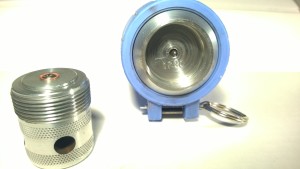
I believe that when I prepared the device, I didn’t thread the cap all the way down to be fully seated. I had noticed the cap was not fully threaded in by about two threads. This may have allowed debris to get in between the threads resulting in the cap to become too tight for me to remove by hand after use. I had to use a vice at home and some WD-40 to assist me in removing the cap. But once I removed it, it still threads on like new and I have not had any further issues to date. Up to that point I have never done any maintenance to the unit, so I recommend to clean the threads every once in a while to keep them clean and free of debris.
Finally let’s look at a cost analysis of different type of grenade systems and their operating costs over a number of uses. Below is a quick reference chart which shows the base cost to operate, no shipping costs were included.
|
Operating Costs (assumes no shipping) | |||||
| Grenade Type |
Startup Cost |
Startup Cost plus 25 shots |
Startup Cost plus 50 shots |
Startup Cost plus 100 shots |
Startup Cost plus 200 shots |
| Pea Grenade ver2 |
$5 |
$125 |
$250 |
$500 |
$1,000 |
| Pea Grenade ver3 |
$11.48 |
$287 |
$574 |
$1,148 |
$2,296 |
| Thunder B |
$41 |
$64 |
$108 |
$195 |
$391 |
| VTG with .209 primer adapter |
$94.60 |
$96 |
$98 |
$101 |
$107 |
| VTG with 9mm pax adapter |
$113.52 |
$123 |
$133 |
$152 |
$191 |
| VTG with 12-gauge short cartridge |
$94.60 |
$120 |
$143 |
$191 |
$287 |
If you look at the chart you can see although the initial cost for the Pea-grenades are cheaper at the beginning, the cost dramatically increases the more you utilize them since they are a onetime use item. The Thunder B is in middle of the pack for startup costs and even though the price increases with more use, the overall rate of increase is manageable. Then if you look at the V.T.G. you can clearly see it has the highest initial startup cost by far but if you look at the long term operating cost and the three options that it can provide, you can see where the Versatile Training Grenade really shines.
The 0.209 adapter is easily the cheapest route as long as the 68 decibels it produces meets your needs. If you want something a bit louder and comparable to the Thunder B, the 9mm and 9mm adapter is not a bad alternative for continuing operating cost, especially if you couple the grenades reliability into the equation. Then if 120 decibels are not enough for you, you have the 12- gauge short cartridge option. The 12-gauge option is still comparatively less expensive in the long run compared to the alternatives.
But what should you do with all this information? Well, that is entirely up to you and your needs. If you are looking for a true explosive training grenade, one of the Pea-grenade versions is the best option for you. If you are looking for a middle of the row in terms of a cost solution and a device that has no pyrotechnics and no fire danger, then the Thunder B is a good solution. If you are looking for a reusable and adaptable training device with a low operating cost in the long run, S.W.A.T Training Devices’ Versatile Training Grenade could be a great option to consider. In any case, identify and prioritize your training needs and see which training grenade solution is the best fit for you.
For more information on the Versatile Training Grenade visit http://www.blankfiringgrenade.com/.
Below are is the pricing I used to make these basic pricing assumptions.
Pea Grenade ver. 2- $5 http://www.tlsfx.co.uk
Pea Grenade ver. 3- $11.48 http://www.tlsfx.co.uk
Thunder B
Core plus 12 shells $35 =2.91 http://www.evike.com
12 Shells $15 = 1.25 source http://www.evike.com
CO2 40 shells for $20 = .5 http://www.ebay.com/itm/Crosman-12-Gram-CO2
V.T.G.
V.T.G. = 94.60 http://blankfiringgrenade.co.uk
9mm pax adapter = $18.92 http://blankfiringgrenade.co.uk
9mm pax 50 count = 19.43 https://www.cheaperthandirt.com
.209 shotgun primers 100 count = 6.19 http://www.basspro.com
12-gauge shotgun short cartridge http://www.perfectshotllc.com

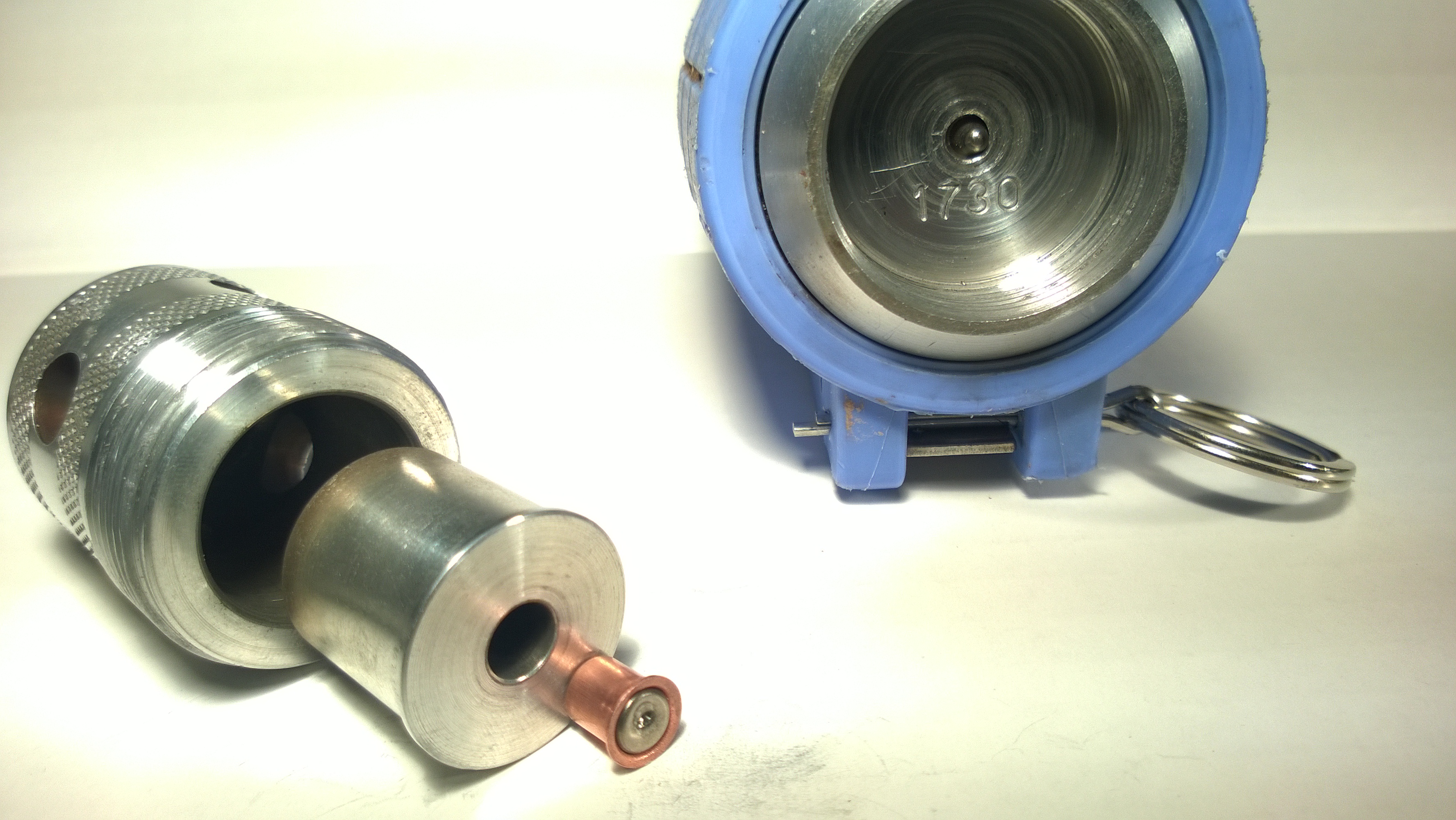
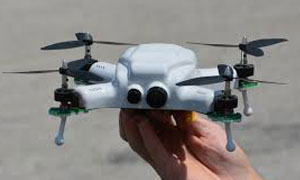
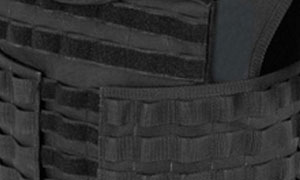
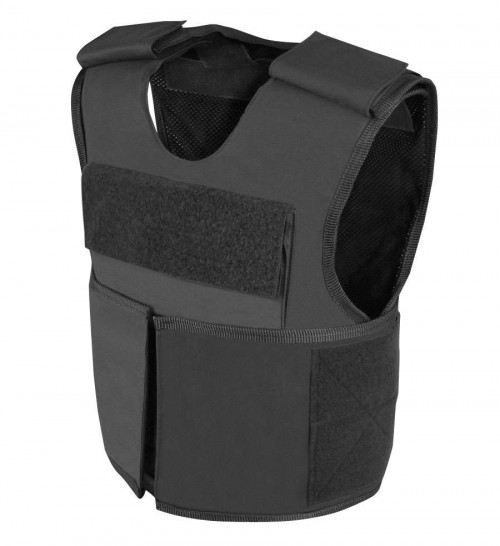
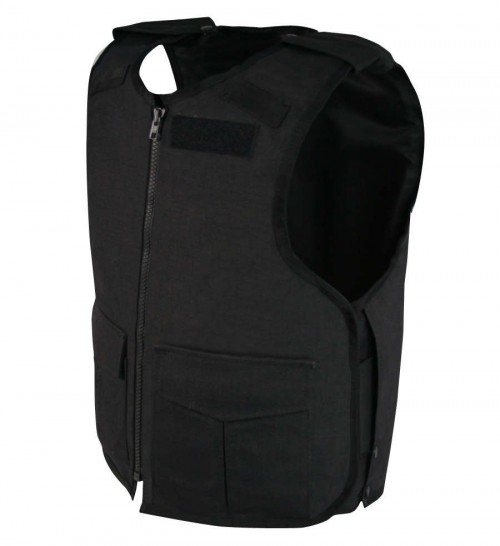
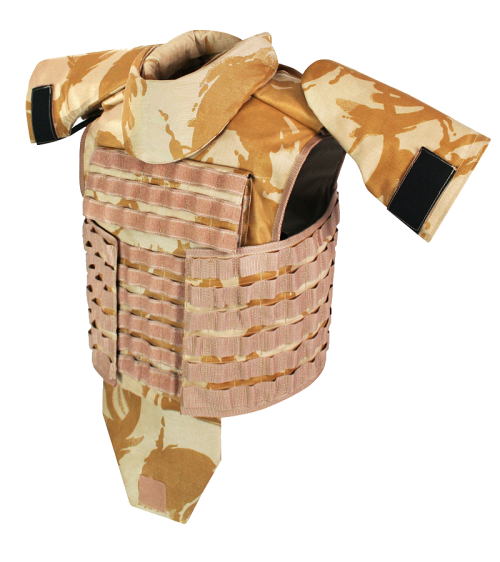

 Bad is such a universally used word. Bad can mean either ends of the spectrum or even everything in-between. Rangers, DELTA and SEALs are bad, meaning they are the best of the best bad asses; or it can be used as in Justin Bieber is bad. Or as in this case it can mean great, as in Bad in Bad Company Tactical (BCT)! A great company with new innovative products that many people have not heard about…. Yet! Their new product line, that I think many people will be talking about, is the BCT Rapid Retention System or R2S for short. Have you ever had trouble finding a holster to fit your weapon with a light, laser or suppressor attached? How about a right vs left handed carry? This may have just become a thing of the past! Almost any attachment (within reason) will not interfere with the operation of the R2S and it’s fully ambidextrous. The system is versatile enough to be used with most of today’s tactical pistols, rifles and many other instruments of the trade. Using this system, changing out your kit to fit the your tactical situation at hand or rearranging kit placement, will only take seconds.
Bad is such a universally used word. Bad can mean either ends of the spectrum or even everything in-between. Rangers, DELTA and SEALs are bad, meaning they are the best of the best bad asses; or it can be used as in Justin Bieber is bad. Or as in this case it can mean great, as in Bad in Bad Company Tactical (BCT)! A great company with new innovative products that many people have not heard about…. Yet! Their new product line, that I think many people will be talking about, is the BCT Rapid Retention System or R2S for short. Have you ever had trouble finding a holster to fit your weapon with a light, laser or suppressor attached? How about a right vs left handed carry? This may have just become a thing of the past! Almost any attachment (within reason) will not interfere with the operation of the R2S and it’s fully ambidextrous. The system is versatile enough to be used with most of today’s tactical pistols, rifles and many other instruments of the trade. Using this system, changing out your kit to fit the your tactical situation at hand or rearranging kit placement, will only take seconds. Let’s first take a look at the system and see what makes it so innovative. The R2S is a two part system, consisting of a base plate (made of Delrin) and adapters (made of 6061-T6 aircraft grade aluminum). The adapter’s triangle-ish shape helps guide the adapter slide into the baseplate in only one direction until the retention system is engaged. The adapter will also not be able to rotate within the base plate and will keep the item in the correct orientation to be drawn. The base plate comes in a standard or slim design and they are extremely rugged and durable. It integrates the stable platform base with the removable level 2 locking mechanism tested to 150 lbs pull weight. Threaded hole patterns on the base plate allow it to be attached to a mounting plate or using Blade Tech, Molle or Tactical Tailor clips to mount the base plate in the vertical, horizontal or angled positions. It can be mounted in a vehicle, to a belt, vest, backpack; or with zip ties, to almost anywhere it can be secured down. The base plate can also utilize 3 types of removable trigger guards: the fitted, universal, or universal fitted as an extra safety feature for use with pistols. For the other half of the system there are several different types of adapters for the different configurations including two new adapters that are just ready for sale now. The Universal adapter, Pistol adapter, rifle adapters, and utility adapters can all utilize the same baseplates but are uniquely made to fit how the retention items will be held to the baseplate.
Let’s first take a look at the system and see what makes it so innovative. The R2S is a two part system, consisting of a base plate (made of Delrin) and adapters (made of 6061-T6 aircraft grade aluminum). The adapter’s triangle-ish shape helps guide the adapter slide into the baseplate in only one direction until the retention system is engaged. The adapter will also not be able to rotate within the base plate and will keep the item in the correct orientation to be drawn. The base plate comes in a standard or slim design and they are extremely rugged and durable. It integrates the stable platform base with the removable level 2 locking mechanism tested to 150 lbs pull weight. Threaded hole patterns on the base plate allow it to be attached to a mounting plate or using Blade Tech, Molle or Tactical Tailor clips to mount the base plate in the vertical, horizontal or angled positions. It can be mounted in a vehicle, to a belt, vest, backpack; or with zip ties, to almost anywhere it can be secured down. The base plate can also utilize 3 types of removable trigger guards: the fitted, universal, or universal fitted as an extra safety feature for use with pistols. For the other half of the system there are several different types of adapters for the different configurations including two new adapters that are just ready for sale now. The Universal adapter, Pistol adapter, rifle adapters, and utility adapters can all utilize the same baseplates but are uniquely made to fit how the retention items will be held to the baseplate. The Universal adapter can be used on almost any picatinny rail system to attach to the base plate. Used on a top or bottom rail, the Universal adapter would mount the attached item in that axis and is very unconventional for retention, but for those few configurations and places it provides an amazing solution to the unique problem. The Universal adapter is mostly used with Machine pistols, M320 40mm grenade launchers, an SBR, etc. Basically if it has a side picatinny rail, you can holster to it to the left or right side! While the R2S Universal can be used almost anywhere on any picatinny rail system, a pistols rail would cause the attachment at a weird angle and most rifle rails are so far forward that only an SBR would be practical, so there are other adapters to better position both pistols and rifles.
The Universal adapter can be used on almost any picatinny rail system to attach to the base plate. Used on a top or bottom rail, the Universal adapter would mount the attached item in that axis and is very unconventional for retention, but for those few configurations and places it provides an amazing solution to the unique problem. The Universal adapter is mostly used with Machine pistols, M320 40mm grenade launchers, an SBR, etc. Basically if it has a side picatinny rail, you can holster to it to the left or right side! While the R2S Universal can be used almost anywhere on any picatinny rail system, a pistols rail would cause the attachment at a weird angle and most rifle rails are so far forward that only an SBR would be practical, so there are other adapters to better position both pistols and rifles. The Rifle adapter is for rifles longer than the SBR lengths, attaches onto the top rail and extends to either the right or the left. These are the new adapters that are just coming out on the market. It gives the longer rifles the ability to be holstered to your side or on a pack in an accessible position. It comes in two standoff widths to accommodate accessories or load outs. The dovetail is designed to withstand a maximum load of 200 lbs. Mounted to the top rail, they allow the rifle to stand off to the side in the ready position, with the rifle’s center of gravity below the attachment point. Bringing the rifle back to the ready position is fast and feels well balanced and controlled.
The Rifle adapter is for rifles longer than the SBR lengths, attaches onto the top rail and extends to either the right or the left. These are the new adapters that are just coming out on the market. It gives the longer rifles the ability to be holstered to your side or on a pack in an accessible position. It comes in two standoff widths to accommodate accessories or load outs. The dovetail is designed to withstand a maximum load of 200 lbs. Mounted to the top rail, they allow the rifle to stand off to the side in the ready position, with the rifle’s center of gravity below the attachment point. Bringing the rifle back to the ready position is fast and feels well balanced and controlled. The Pistol adapter mounts on the bottom rail and brings the holstering point to either the right or left hand side. You can adjust the adapter so that there is a good position height for your hand to rest on the pistol’s grips and have your thumb on the release mechanism. The adapter seems to be in the way, but while using the system you quickly find it a handy resting place for your weak hand’s thumb rest. If you’re worried about losing real estate for your laser or flashlight, you are able to add a rail to the bottom of the adapter for those items! The system also removes the need for multiple holsters for your pistol based on accessories installed. Being creative, the Pistol adapter could be used in a vehicle or even a convenient covert under desk mount that locks in place or with the retention system removed. At the beginning of this article I used the term innovative. In explaining what makes up the system, I’ve touched a bit on why I think it’s so innovative, but think about this for a moment: you would like your kit and loadout to always be specific for the mission you’re conducting, but changing from mission to mission would be next to impossible….. but not so much if you are utilizing the Rapid Retention System. Think about it like this: your belt, drop leg, tactical vest and/or plate carrier, field pack, and vehicle mounts all have the baseplates for the equipment loadouts that would change. You can change your kit from holding magazines, first aid, search & rescue pouches, universal keys, radios and/or weapons to any configuration to fit your immediate needs or mission. Your kit can be switched out or your load changed to a new position as fast as you can clip them in. Now that is innovative!
The Pistol adapter mounts on the bottom rail and brings the holstering point to either the right or left hand side. You can adjust the adapter so that there is a good position height for your hand to rest on the pistol’s grips and have your thumb on the release mechanism. The adapter seems to be in the way, but while using the system you quickly find it a handy resting place for your weak hand’s thumb rest. If you’re worried about losing real estate for your laser or flashlight, you are able to add a rail to the bottom of the adapter for those items! The system also removes the need for multiple holsters for your pistol based on accessories installed. Being creative, the Pistol adapter could be used in a vehicle or even a convenient covert under desk mount that locks in place or with the retention system removed. At the beginning of this article I used the term innovative. In explaining what makes up the system, I’ve touched a bit on why I think it’s so innovative, but think about this for a moment: you would like your kit and loadout to always be specific for the mission you’re conducting, but changing from mission to mission would be next to impossible….. but not so much if you are utilizing the Rapid Retention System. Think about it like this: your belt, drop leg, tactical vest and/or plate carrier, field pack, and vehicle mounts all have the baseplates for the equipment loadouts that would change. You can change your kit from holding magazines, first aid, search & rescue pouches, universal keys, radios and/or weapons to any configuration to fit your immediate needs or mission. Your kit can be switched out or your load changed to a new position as fast as you can clip them in. Now that is innovative! The Rapid Retention System has been used by private contractors and is currently being evaluated by SWAT. This system is very innovative and it’s uses are only limited by your imagination on how it can be utilized for your varying missions. For those whose lives rely on their equipment, you can rely on the company with leading edge tactical equipment. …. and you can be all kinds of bad…. Bad Company Tactical R2S.
The Rapid Retention System has been used by private contractors and is currently being evaluated by SWAT. This system is very innovative and it’s uses are only limited by your imagination on how it can be utilized for your varying missions. For those whose lives rely on their equipment, you can rely on the company with leading edge tactical equipment. …. and you can be all kinds of bad…. Bad Company Tactical R2S.
 Here in Arizona, rain is always a good thing but when it’s a Black Rain, it’s even better! A few months ago, TACSIM Media Group took possession of a Black Rain Ordnance’s D.I gas PG-9 rifle with the NORGUARD finish. This is by far the nicest looking rifle we’ve reviewed to date and the first AR that didn’t start out mostly with a black finish. But don’t be fooled as I initially was, that the Black Rain Ordnance (BRO) is not just another pretty face, it has what it takes to continually put rounds down range and on target.
Here in Arizona, rain is always a good thing but when it’s a Black Rain, it’s even better! A few months ago, TACSIM Media Group took possession of a Black Rain Ordnance’s D.I gas PG-9 rifle with the NORGUARD finish. This is by far the nicest looking rifle we’ve reviewed to date and the first AR that didn’t start out mostly with a black finish. But don’t be fooled as I initially was, that the Black Rain Ordnance (BRO) is not just another pretty face, it has what it takes to continually put rounds down range and on target. The PG-9’s standard features are really great, sporting Magpul MOE stocks and grips, ASAP (Ambidextrous Sling Attachment Point) with a BRO Single Point Sling and one (30) rnd PMAG. It also comes with BROs 9 inch quad rail and KNS mod 2 anti-roll pins installed. The 16 inch Stainless Straight Fluted machined barrel with its ultra-unique flash hider really sets this weapon apart from the norm. But one of the nicest things was the BRO’s very impressive drop in trigger. The only thing that it didn’t come with was sights and optics! This was not a problem since most people are picky on the choice of sights based on the optics. My choice of sights are the Yankee Hill Machine 9680/9627 back-up sights and an EoTech 552 optic.
The PG-9’s standard features are really great, sporting Magpul MOE stocks and grips, ASAP (Ambidextrous Sling Attachment Point) with a BRO Single Point Sling and one (30) rnd PMAG. It also comes with BROs 9 inch quad rail and KNS mod 2 anti-roll pins installed. The 16 inch Stainless Straight Fluted machined barrel with its ultra-unique flash hider really sets this weapon apart from the norm. But one of the nicest things was the BRO’s very impressive drop in trigger. The only thing that it didn’t come with was sights and optics! This was not a problem since most people are picky on the choice of sights based on the optics. My choice of sights are the Yankee Hill Machine 9680/9627 back-up sights and an EoTech 552 optic. Some of the other features are:
Some of the other features are: When I first saw the NORGUARD finish, my first thought was, I’d never paint this! And that still holds true. I would never want to paint it. It’s an amazing finish that took me a few trips to the range before I really started to appreciate it. It’s not something that I normally would think I’d like, but it definitely grows on you. I’m normally all about the black rifle and/or camo’ing your rifles for the operational environment, so this was something new for me….. and I liked it! It does tend to gather a crowd of onlookers and inquisitive people. They are taken aback once they realize that there is something different about the finish. I wish I knew more about the finish at the time to give more of an informed answer to their questions.
When I first saw the NORGUARD finish, my first thought was, I’d never paint this! And that still holds true. I would never want to paint it. It’s an amazing finish that took me a few trips to the range before I really started to appreciate it. It’s not something that I normally would think I’d like, but it definitely grows on you. I’m normally all about the black rifle and/or camo’ing your rifles for the operational environment, so this was something new for me….. and I liked it! It does tend to gather a crowd of onlookers and inquisitive people. They are taken aback once they realize that there is something different about the finish. I wish I knew more about the finish at the time to give more of an informed answer to their questions. The second and third outings were certainly more enjoyable since I didn’t have to continually clean the barrel and inspect parts and just put rounds down range. It’s very therapeutic! I had my minion helpers, Hernaldo and Paul, who are always ready to squeeze some triggers and help me put more rounds through our test rifles. I often let people at the range squeeze a few rounds through a weapon that they are really interested in, and shooting the PG-9 only made them want one more! They were all very impressed with how it shot. This rifle has so much appeal that at one time I think I had six people around me asking questions about it. Not bad considering I was down at one end of the range.
The second and third outings were certainly more enjoyable since I didn’t have to continually clean the barrel and inspect parts and just put rounds down range. It’s very therapeutic! I had my minion helpers, Hernaldo and Paul, who are always ready to squeeze some triggers and help me put more rounds through our test rifles. I often let people at the range squeeze a few rounds through a weapon that they are really interested in, and shooting the PG-9 only made them want one more! They were all very impressed with how it shot. This rifle has so much appeal that at one time I think I had six people around me asking questions about it. Not bad considering I was down at one end of the range. I was initially very impressed with the Black Rain Ordnance PG-9 rifle design and all the features and attention to detail that are included in the build. I was just out of my comfort zone when it came to the finish. I have to say, that after only a few trips out to the range, I have changed my zone of comfort to include a finish other than black or coated ARs. I have also found that the feel of the rifle is very comfortable because of its weight and balance. I think it may have been said before, but there’s nothing better than a good rain. So…. Let it Rain!
I was initially very impressed with the Black Rain Ordnance PG-9 rifle design and all the features and attention to detail that are included in the build. I was just out of my comfort zone when it came to the finish. I have to say, that after only a few trips out to the range, I have changed my zone of comfort to include a finish other than black or coated ARs. I have also found that the feel of the rifle is very comfortable because of its weight and balance. I think it may have been said before, but there’s nothing better than a good rain. So…. Let it Rain!